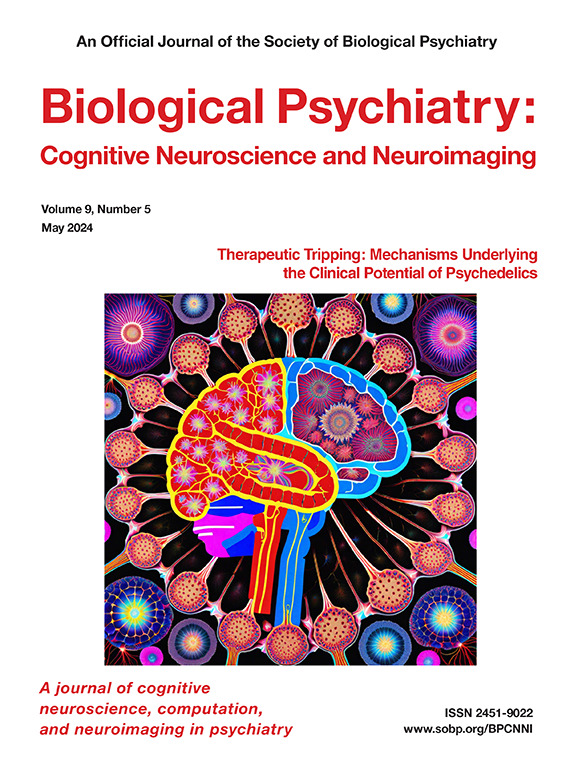Functional Brain Connectivity Predictors of Prospective Substance Use Initiation and Their Environmental Correlates
IF 5.7
2区 医学
Q1 NEUROSCIENCES
Biological Psychiatry-Cognitive Neuroscience and Neuroimaging
Pub Date : 2025-02-01
DOI:10.1016/j.bpsc.2024.10.002
引用次数: 0
Abstract
Background
Early substance use initiation (SUI) places youth at substantially higher risk for later substance use disorders. Furthermore, adolescence is a critical period for the maturation of brain networks, the pace and magnitude of which are susceptible to environmental influences and may shape risk for SUI.
Methods
We examined whether patterns of functional brain connectivity during rest (rsFC), measured longitudinally during pre- and early adolescence, can predict future SUI. Next, in an independent subsample, we tested whether these patterns were associated with earlier environmental exposures, specifically neighborhood pollution and socioeconomic dimensions. We utilized data from the ABCD (Adolescent Brain Cognitive Development) Study. SUI was defined as first-time use of at least 1 full dose of alcohol, nicotine, cannabis, or other drugs. We created a control group (n = 228) of participants without SUI who were matched to the SUI group (n = 233) on age, sex, race/ethnicity, household income, and parental education.
Results
Multivariate analysis showed that whole-brain rsFC from 9–10 to 11–12 years of age (prior to SUI) prospectively differentiated the SUI and control groups. The SUI-related rsFC pattern was also related to aging in both groups, suggesting a pattern of accelerated maturation in the years prior to SUI. This same pattern of rsFC was predicted by higher pollution but not neighborhood disadvantage (adjusted for family socioeconomic factors) in an independent subsample (n = 2854).
Conclusions
Brain functional connectivity patterns in early adolescence that are linked to accelerated maturation can predict SUI in youth and are associated with exposure to pollution.
未来开始使用药物的大脑功能连接预测因素及其环境相关性。
背景:过早开始使用药物(SUI)会大大增加青少年日后出现药物使用障碍的风险。此外,青春期是大脑网络成熟的关键时期,而大脑网络成熟的速度和程度很容易受到环境的影响,并可能决定青少年罹患药物滥用症的风险:我们研究了在青春期前期和早期纵向测量的静息时大脑功能连接(rsFC)模式是否能预测未来的 SUI。接下来,我们在一个独立的子样本中测试了这些模式是否与早期的环境暴露有关,特别是邻里污染和社会经济因素。我们利用了青少年脑认知发展研究(ABCD)® 的数据。SUI 被定义为首次使用至少一次全剂量酒精、尼古丁、大麻或其他药物。我们设立了一个对照组(N = 228),由没有 SUI 的参与者组成,他们与 SUI 组(N = 233)在年龄、性别、种族/民族、父母收入和教育程度方面相匹配:多变量分析表明,从 9-10 岁到 11-12 岁(SUI 之前)的全脑 rsFC 可对 SUI 组和对照组进行前瞻性区分。与 SUI 相关的 rsFC 模式也与两组人的年龄增长有关,这表明在 SUI 之前的几年中,人的成熟速度加快。在一个独立的子样本(N = 2,854)中,污染程度越高,但邻里关系越差(根据家庭社会经济因素调整),也能预测出同样的rsFC模式:结论:与加速成熟有关的青春期早期大脑功能连接模式可以预测青少年的 SUI,并且与暴露于污染有关。
本文章由计算机程序翻译,如有差异,请以英文原文为准。
求助全文
约1分钟内获得全文
求助全文
来源期刊

Biological Psychiatry-Cognitive Neuroscience and Neuroimaging
Neuroscience-Biological Psychiatry
CiteScore
10.40
自引率
1.70%
发文量
247
审稿时长
30 days
期刊介绍:
Biological Psychiatry: Cognitive Neuroscience and Neuroimaging is an official journal of the Society for Biological Psychiatry, whose purpose is to promote excellence in scientific research and education in fields that investigate the nature, causes, mechanisms, and treatments of disorders of thought, emotion, or behavior. In accord with this mission, this peer-reviewed, rapid-publication, international journal focuses on studies using the tools and constructs of cognitive neuroscience, including the full range of non-invasive neuroimaging and human extra- and intracranial physiological recording methodologies. It publishes both basic and clinical studies, including those that incorporate genetic data, pharmacological challenges, and computational modeling approaches. The journal publishes novel results of original research which represent an important new lead or significant impact on the field. Reviews and commentaries that focus on topics of current research and interest are also encouraged.
 求助内容:
求助内容: 应助结果提醒方式:
应助结果提醒方式:


